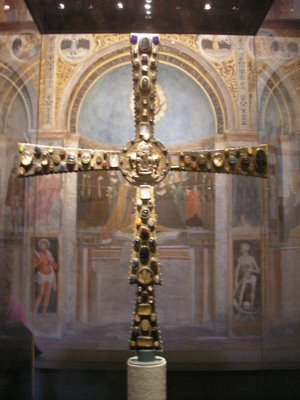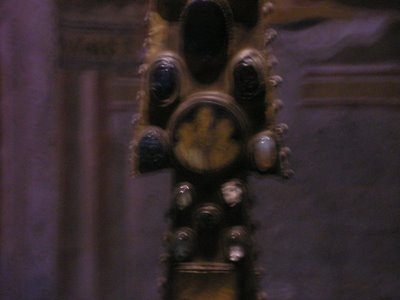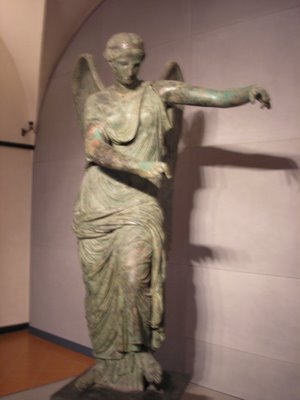Santa Giulia (4)
On the other itinerary at the museum, one finds an incredibly ornate jeweled cross, put together out of various pieces in the seventh century. One of those pieces, just over half-way down the lower arm of the cross, is a medallion from the Roman Empire (if you click on the photo to view it in a larger size in its own window, you might be able at least to make it out in general terms; my zoom-in shot is too blurry to see any details, though I’ve included it anyway). 

Jas Elsner briefly discusses the object in the introduction to Imperial Rome and Christian Triumph: The Art of the Roman Empire AD 100-450 (Oxford, 1998). In his caption, he writes (p. 22), ‘Gold-glass medallion, perhaps from Alexandria, dated anywhere between the early third and the mid-fifth centuries AD. This family group of a mother, in a richly embroidered robe and jewels, with her son and daughter, bears the inscription BOUNNERI KERAMI. This may be an artist’s signature or the name of the family represented.’
In his remarks in the text, he states (p. 23):
...[T]here are...profound continuities between the visual productions of the pagan and Christian empires, as the following chapters will show. Take, for example, the beautiful gold-glass medallion from Brescia, which could have been made at any point in our period–its transfixing naturalism gestures towards the second century, while its technique is more typical of objects from the fourth. Perhaps from Alexandria, since its inscription is in the Alexandrian dialect of Greek, it probably found its way early to Italy–at any rate, it was incorporated there in the seventh century in a ceremonial, jewelled, cross. Whenever it was made, and for the duration of its use in antiquity, the imagery of this gem speaks of the continuity and values of family life, of the wealth and patronage of aristocratic elites, of the high value placed on exquisite workmanship from the second century to the fifth.




